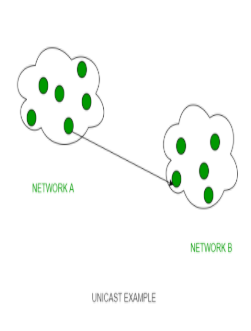Difference between Unicast and Broadcast
Last Updated :
29 Oct, 2020
1. Unicast :
Unicast is a type of information transfer and it is used when there is a participation of single sender and single recipient. So, in short, you can term it as a one-to-one mapping. For example, a device having IP address 10.1.4.0 in a network wants to send the traffic stream (data packets) to the device with IP address 20.14.4.2 in the other network, then unicast comes into the picture. It is the most common form of data transfer over the networks.

2. Broadcast :
Broadcast transfer (one-to-all) techniques and can be classified into two types : Limited Broadcasting, Direct Broadcasting. In broadcasting mode, transmission happens from one host to all the other hosts connected on the LAN. The devices such as bridge uses this. The protocol like ARP implement this, in order to know MAC address for the corresponding IP address of the host machine. ARP does ip address to mac address translation. RARP does the reverse.

Difference between Unicast and Broadcasting :
| S.No. |
Unicast |
Broadcast |
| 1. |
It has one sender and one receiver. |
It has one sender and multiple receivers. |
| 2. |
It sends data from one device to single device. |
It sent data from one device to all the other devices in a network. |
| 3. |
It works on Single Node Topology. |
It works on star and bus topology. |
| 4. |
It does not scale well for streaming media. |
It scale well across large networks. |
| 5. |
Multiple unicasting utilizes more bandwidth as compared. |
Its bandwidth is wasted. |
| 6. |
Web surfing, file transfer is an example of a unicast. |
Hub is an example of a broadcast device. |
| 7. |
It has one-to-one mapping. |
It has one-to-all mapping. |
Like Article
Suggest improvement
Share your thoughts in the comments
Please Login to comment...